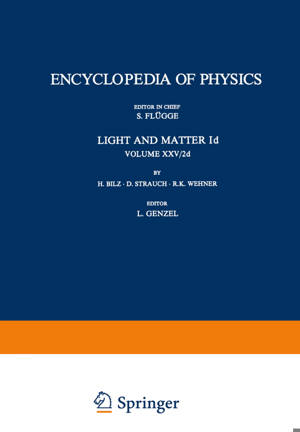
- Afhalen na 1 uur in een winkel met voorraad
- Gratis thuislevering in België vanaf € 30
- Ruim aanbod met 7 miljoen producten
- Afhalen na 1 uur in een winkel met voorraad
- Gratis thuislevering in België vanaf € 30
- Ruim aanbod met 7 miljoen producten
Zoeken
Light and Matter Id / Licht Und Materie Id
Infrared and Raman Spectra of Non-Metals
H Bilz, D Strauch, R K Wehner
€ 150,48
+ 300 punten
Omschrijving
The dynamical properties of solids have recently attracted renewed interest in connection with the increasing understanding of phase transitions and re- lated phenomena. In particular, soft modes or, more generally, phonon 'anom- alies' seem to play an important role in structural and electronic phase tran- sitions, such as ferroelectric or superconducting transitions. The understanding of the mechanisms responsible for the occurrence of unusually low frequencies in phonon spectra requires a detailed analysis of the microscopic forces governing the lattice vibrations. Of particular importance is the influence of the electron- lattice interaction in the adiabatic approximation which in many cases is the origin of peculiarities in the phonon self-energy. In this work the vibrational spectra of pure non-metals and of those con- taining point defects are investigated. ' In these materials the interrelation be- tween the pseudo-harmonic forces (determining the phonon dispersion re- lations) and the non-linear anharmonic and electron-phonon forces (as they act in infrared and Raman spectra) is most obvious and can be quantitatively analysed in terms of appropriate models. The main task is to arrive at a physically correct treatment of electronic degrees of freedom, as for example in an electronic 'shell' model, which leads to the description of phonon spectra in terms of long-range polarizabilities and short-range deformabilities. The pur- pose of our review is to stimulate further investigations which, we hope, will result in explicit relations between the parameters of the semi-microscopic models and the matrix elements from the electronic band structure.
Specificaties
Betrokkenen
- Auteur(s):
- Uitgeverij:
Inhoud
- Aantal bladzijden:
- 602
- Taal:
- Engels
- Reeks:
- Reeksnummer:
- nr. 5
Eigenschappen
- Productcode (EAN):
- 9783642464355
- Verschijningsdatum:
- 10/03/2012
- Uitvoering:
- Paperback
- Formaat:
- Trade paperback (VS)
- Afmetingen:
- 170 mm x 244 mm
- Gewicht:
- 970 g

Alleen bij Standaard Boekhandel
+ 300 punten op je klantenkaart van Standaard Boekhandel
Beoordelingen
We publiceren alleen reviews die voldoen aan de voorwaarden voor reviews. Bekijk onze voorwaarden voor reviews.








